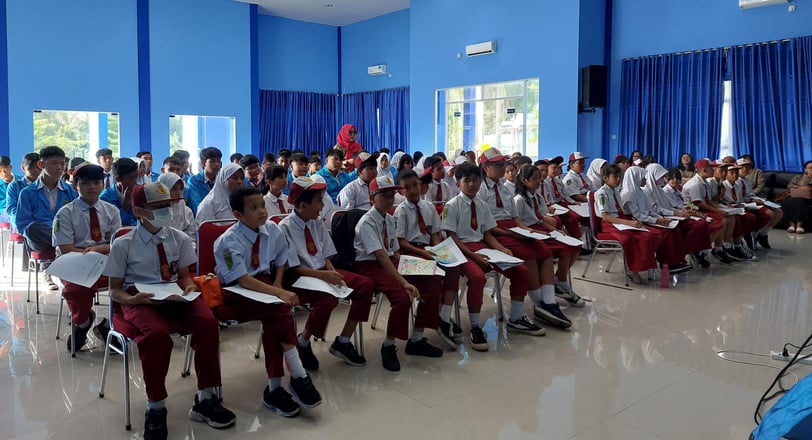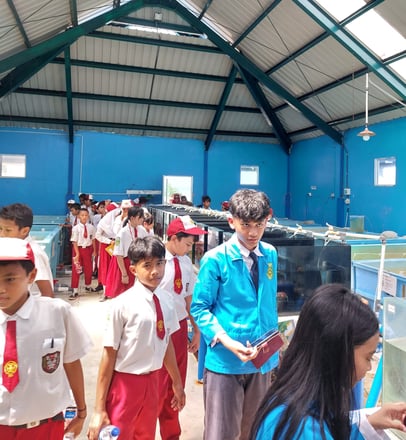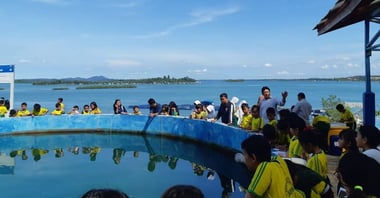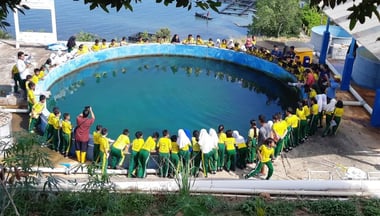Exploring Marine Life Education: Taman Siswa Batam's Visit to the Batam Center for Marine Aquaculture
Taman Siswa Batam recently conducted a highly meaningful visit to the Batam Center for Marine Aquaculture (Balai Perikanan Budidaya Laut Batam). This activity was designed to provide students with direct education about marine life and the aquaculture techniques applied in Indonesia.
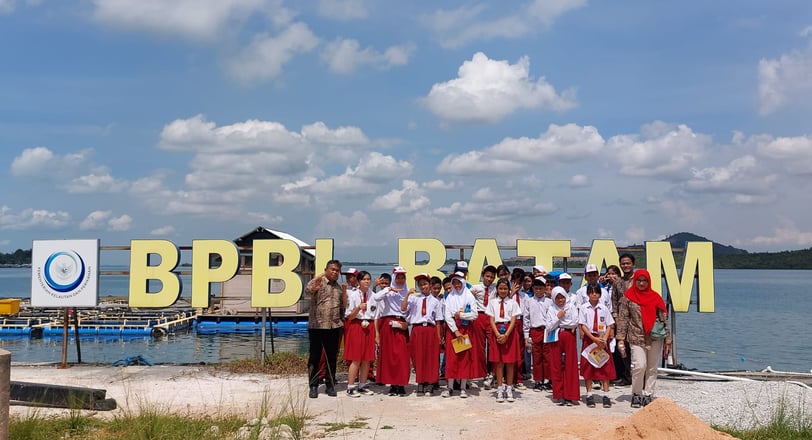

Aquaculture plays a pivotal role in marine life education, as it presents a practical approach to sustaining and managing marine resources. As global populations continue to rise, the demand for seafood has led to overfishing and habitat degradation. By educating students about aquaculture practices and sustainable fishing methods, they become equipped with the knowledge needed to contribute to the health and sustainability of marine ecosystems. This kind of education is vital for instilling a sense of urgency regarding biodiversity preservation and promoting innovative solutions to environmental challenges.
Through initiatives like monthly visits to the Batam Center for Marine Aquaculture, students gain first-hand insights into the interconnectedness of marine life and the importance of safeguarding our oceans. Such experiences not only deepen their understanding but also inspire a generation of responsible stewards dedicated to the promotion of marine life conservation. The impact of marine life education can be profound, influencing behaviors and values that endure into adulthood.
Overview of Taman Siswa Batam's Initiatives
Taman Siswa Batam is a prominent educational institution committed to fostering a holistic understanding of environmental issues, particularly those related to marine life. As a school deeply rooted in progressive educational values, Taman Siswa Batam places a strong emphasis on experiential learning, encouraging students to actively engage with their surroundings. The institution’s vision is centered on developing environmentally conscious citizens who are well-informed about the significance of preserving marine ecosystems.
In line with this vision, Taman Siswa Batam has launched various initiatives aimed at enhancing students’ awareness of marine biodiversity. One significant program is the integration of marine biology into the curriculum, fostering an understanding of marine ecosystems and the importance of marine conservation. This initiative not only equips students with scientific knowledge but also ingrains a sense of responsibility towards environmental stewardship.
Additionally, Taman Siswa Batam frequently organizes field trips and community engagement activities that immerse students in practical experiences related to marine life. For example, visits to the Batam Center for Marine Aquaculture provide students with the opportunity to observe and interact with various marine organisms, reinforcing the importance of aquaculture in sustainable fishing practices. Such hands-on experiences are invaluable, as they transition theoretical knowledge gained in the classroom to real-world applications.
By prioritizing these initiatives, Taman Siswa Batam aims to cultivate a generation that appreciates marine resources and recognizes its critical role in sustaining biodiversity. The school’s commitment to enhancing environmental awareness is evident in its efforts to promote responsible practices within the student body and the broader community. Through these initiatives, Taman Siswa Batam stands as a model for integrating marine life education into formal schooling, ultimately nurturing environmentally responsible future leaders.
The Importance of the Visit to Batam Center for Marine Aquaculture
The visit to the Batam Center for Marine Aquaculture represents a significant opportunity for students from Taman Siswa Batam to engage with marine sciences in a practical setting. This excursion serves multiple educational objectives, primarily aimed at enhancing students' understanding of marine ecosystems and aquaculture practices. By stepping outside the classroom, students are able to witness firsthand the various methodologies used in marine cultivation, which starkly contrasts with theoretical knowledge taught in schools.
One of the vital aspects of such visits is the ability to observe real-time aquaculture operations. This exposure allows students to grasp the complexities of marine life management, from breeding techniques to water quality assessment. It equips them with tangible experiences that complement their academic learning. Students gain insights into environmental conservation and sustainable practices, fostering a sense of responsibility towards marine ecosystems. Additionally, interacting with professionals in the field provides inspiration and could ignite potential career interests in marine biology, environmental science, or aquaculture.
Moreover, visits to marine centers like the Batam Center for Marine Aquaculture bridge the often-noted gap between academic concepts and their practical applications. By conducting hands-on activities, students can engage in critical thinking and problem-solving tasks that refine their understanding of marine habitats. Such experiential learning encourages curiosity and drives the desire to explore complex marine environments. Furthermore, these interactions can stimulate discussions about ecological balance, species preservation, and the economic significance of marine resources.
Incorporating visits to marine aquaculture facilities into the curriculum highlights the importance of informed stewardship of oceanic resources. Overall, this trip is not merely an educational excursion; it marks an essential step in promoting active learning and environmental consciousness among young students, ultimately cultivating a future generation that values marine life.
Learning about Marine Biodiversity
During their visit to the Batam Center for Marine Aquaculture, students from Taman Siswa Batam engaged in an enlightening exploration of marine biodiversity. This experience provided them with a unique opportunity to encounter a variety of marine species, each playing a significant role in the oceanic ecosystem. The aquatic world is rich with diversity, comprising fish, mollusks, crustaceans, and numerous other organisms, each contributing to the balance and health of marine environments.
Students learned about the interplay between different species and their habitats. For instance, coral reefs were highlighted as critical ecosystems that support a multitude of marine life. These reefs serve as nurseries for young fish, provide shelter to various species, and are integral to maintaining the ocean's ecological balance. The discussion also encompassed the importance of keystone species, like sea otters and certain types of sharks, which have a disproportionately large impact on their ecosystems. The removal or decline of such species can lead to significant changes, often detrimental, in marine populations.
Furthermore, the educational session included insights into the threats faced by marine biodiversity, primarily due to human activities such as overfishing, pollution, and climate change. Students were made aware of the critical need to protect marine habitats to ensure a sustainable future for all species, including those vital to human life. They discussed conservation efforts and the role individuals can play in supporting marine preservation initiatives, emphasizing the interconnectedness of human activities and marine health.
The visit to the aquaculture center was not only informative but also served as a catalyst for students to consider their responsibilities toward the ocean. As future stewards of the environment, understanding marine biodiversity and its significance is crucial for fostering a culture of conservation in the next generation. Through learning about these essential ecosystems, students are encouraged to advocate for the protection of marine habitats and to contribute positively to the conservation efforts in their communities.
Insights into Aquaculture Techniques in Indonesia
Aquaculture in Indonesia is an essential component of the nation's approach to sustainable marine life cultivation. During their visit to the Batam Center for Marine Aquaculture, students from Taman Siswa Batam observed various innovative techniques employed to enhance marine resource management and contribute to food security. Given Indonesia's vast archipelagic territory, with over 17,000 islands, aquaculture plays a pivotal role in meeting the growing demand for seafood while alleviating pressure on wild stocks.
One of the primary techniques utilized in Indonesian aquaculture is the use of integrated multi-trophic aquaculture (IMTA). This approach involves cultivating multiple species simultaneously in a single ecosystem, thereby creating a balanced environment. For instance, fish, shellfish, and seaweed are raised together, allowing for nutrient recycling that optimizes growth and reduces waste. This not only maximizes production but also promotes ecological sustainability, which is crucial in the context of rising environmental concerns.
The students also learned about the application of advanced technology in aquaculture practices. Innovations such as floating cages and biosecurity measures significantly enhance the health of cultivated species while minimizing disease outbreaks. Such measures are vital, especially in tropical waters where temperature fluctuations can impact marine organisms. Furthermore, the integration of scientific research into breeding programs has led to the development of more resilient fish stocks, ensuring the sustainability of aquaculture operations.
Additionally, education and community involvement are focal points in Indonesia's aquaculture strategies. Local fisherfolk receive training on sustainable practices which empowers them to manage aquaculture facilities more effectively. This grassroots involvement not only aids in preserving marine resources but also supports local economies, showcasing the socio-economic significance of aquaculture in Indonesia. The experiences at the Batam Center provide valuable insights into these techniques, emphasizing the importance of fostering sustainable aquaculture practices for future generations.
Engaging with Experts in Marine Sciences
During the visit to the Batam Center for Marine Aquaculture, students from Taman Siswa Batam had the opportunity to engage with marine scientists and aquaculture experts, paving the way for profound interactions that enriched their understanding of marine life and its preservation. These encounters served as a glimpse into the diverse fields of marine biology, conservation, and environmental sciences, fostering a sense of curiosity and interest among the students.
One of the highlights of the visit was a detailed discussion led by a marine biologist specializing in coral reef ecosystems. The expert shared insights into the complex relationships within marine habitats and the importance of maintaining biodiversity. Students were encouraged to ask questions, allowing them to delve deeper into topics such as coral bleaching, climate change impacts, and sustainable aquaculture practices. This interactive dialogue not only clarified current marine challenges but also illuminated potential career paths for students interested in pursuing studies in marine sciences.
Another engaging segment featured a presentation on aquaculture techniques, tailored to foster environmentally sustainable practices. Experts explained how innovative approaches can mitigate overfishing while ensuring food security. The discourse on the integration of technology in aquaculture sparked enthusiasm among students. Their inquiries ranged from specific practices to broader environmental implications, demonstrating a keen interest in how technology can shape the future of marine life management.
The visit culminated in a series of hands-on workshops, where students could apply their newfound knowledge in practical scenarios. These activities ranged from water quality testing to species identification, aiming to enhance scientific literacy and motivate students to explore the vibrant field of marine studies. By interacting with professionals committed to marine ecology, the students of Taman Siswa Batam were left inspired and informed, considering their roles in future conservation efforts and the importance of pursuing careers in marine sciences.
Conclusion
The visit of Taman Siswa Batam to the Batam Center for Marine Aquaculture marks a significant milestone in marine life education. This immersive experience not only enriched the students' knowledge of marine ecosystems but also underscored the profound importance of preserving these vital environments. Through direct interaction with marine species and the understanding of aquaculture practices, students were able to witness firsthand the intricacies of marine life and the delicate balance of aquatic habitats.
The outcomes of this educational excursion are far-reaching. Students left with a greater appreciation for biodiversity and the challenges faced by marine environments, such as pollution and climate change. This firsthand experience fosters a sense of responsibility and stewardship, encouraging students to become advocates for the protection of marine ecosystems. Furthermore, such visits provide a contextual framework that enhances theoretical lessons learned in the classroom, making the subject matter more relatable and impactful.
In the context of ongoing environmental issues, the importance of investing in marine life education cannot be overstated. It is essential to cultivate interest and awareness among young individuals, as they are the future guardians of our planet's oceans. Educational initiatives like the one witnessed at Batam Center serve to inspire the next generation to engage in conservation efforts and to understand the complexities of marine biodiversity.
Ultimately, the lasting impact of this visit extends beyond the classroom, nurturing informed and passionate individuals who are willing to advocate for sustainable practices. As we continue to face challenges in marine conservation, it is imperative that we maintain and enhance programs aimed at marine life education, ensuring that future generations are equipped to protect and conserve our planet’s invaluable marine resources.
